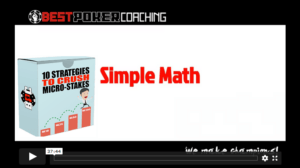Making the final table in a large field MTT is a rare occurrence but one you should still be prepared for. It plays much different than a single table SNG because starting stacks can vary greatly and the blinds and antes are typically very high. Also, everyone at the final table is already in the money, however, with each elimination, the payout becomes significantly bigger.
No final table is alike and knowing how to adjust will make or break your chances of winning. The blinds are typically very high at this stage and will force you to be all-in frequently. Being comfortable with getting your chips in the middle regularly isn’t always fun but a necessary part of the game if you want to take it down. Of course, you also need to realize the difference between aggressive play and being recklessly stupid, since making mistakes at this stage of the tournament are highly magnified and will surely cost you big.
SIZE DOES MATTER
In part 8 of this series, you learned that a winning strategy during the late stages of MTT play is largely dependent on your stack size in relation to the blinds. As the final table progresses and players are eliminated, you will also need to adjust to short-handed play as well as several other variables such as the playing style of your opponents, but the general strategy remains the same.
If you find yourself short on chips at the final table (10 big blinds or less), you need to look for opportunities to double up. If you have around 15 big blinds, you can sometimes afford to let a maniac take a few people out in hopes of a higher payoff. But that won’t always be the case. Once you have around 20 big blinds, you can ditch the push/fold strategy and switch gears to a tight/aggressive style.
For larger stacks, you should be applying a ton of pressure on the rest of the players by regularly stealing pots both preflop and postflop when in position. Be very opportunistic, especially as the chip leader, but also avoid getting into big confrontations early against effective or near-effective chip stacks.
REMEMBER ICM
You should know by now that ICM is a very important and effective concept for tournament play. At the final table, it’s even more useful. The reason for this is because it aids in optimal decision making and the hand ranges for doing so. As stressed previously in this series, I strongly recommend taking advantage of ICM tools such as ICMIZER or SNGWizard to improve your play when you reach a final table. Remember, ICM is about making decisions in terms of tournament equity (monetary profitability) rather than chip equity. If you need to review ICM further, go back to part 8 of this series.
KNOW YOUR OPPONENTS
As the old saying goes, play the player, not the cards. Never is this truer than at the final table. In the early stages of a tournament, players come and go frequently, all with different styles of play. At the final table, however, most players are going to range from fairly competent to pretty solid. Once in a while, you’ll see a mega fish at the final table who caught a lucky streak of cards, but it’s rare. If you’re not extremely short on chips, playing very tight for the first round or so can be beneficial to get a feel for the table. Try to identify any strengths and weaknesses for each player and adjust accordingly.
SHORT-HANDED ADJUSTMENTS
As players are eliminated, the table will become short-handed and eventually down to just heads up. Short-handed play requires you to adjust your starting hand requirements as well as the hand ranges of your opponents. It’s also important to remember that the blinds will come around faster as each player busts. You simply cannot afford to play as if it were a normal full ring table. It’s an absolute must to widen your starting hand ranges and increase your aggression in position as the table gets short. Some players won’t adjust efficiently, or at all, so identify these players and attack them. Remember, the difference between 6th place and 1st place is huge, so once you’re short-handed, go for the win! In the next lesson, you’ll learn some tips on how to play heads up and take it down.



